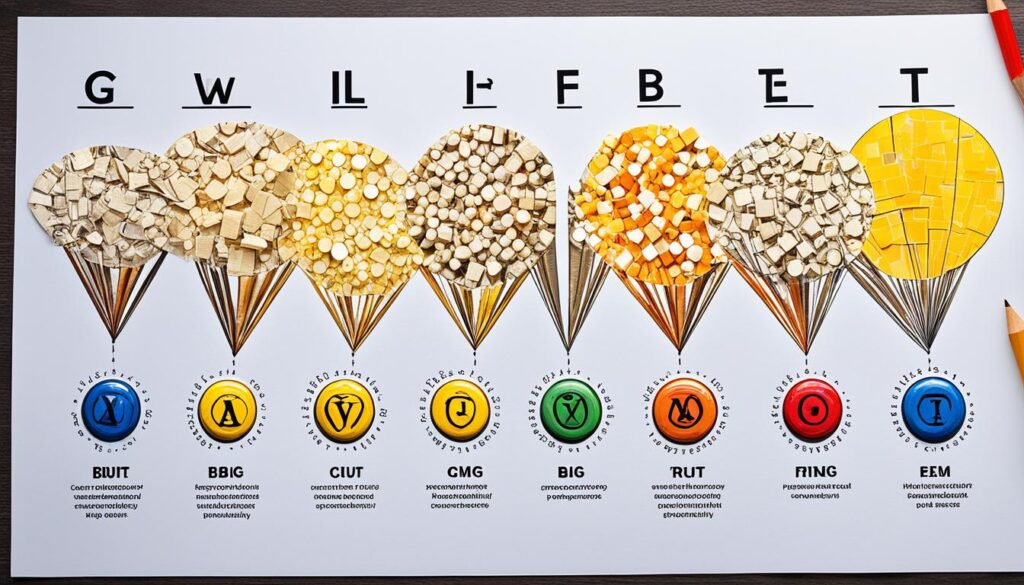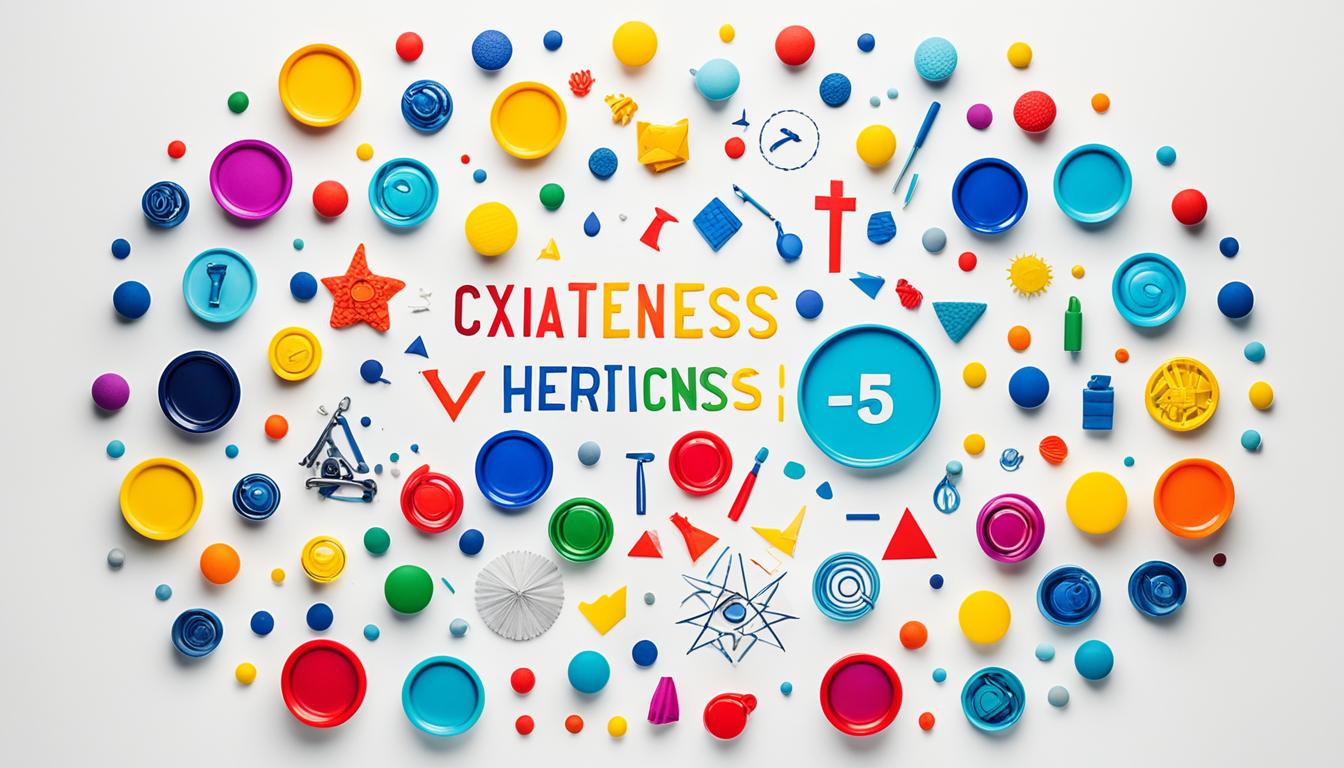The Big 5 Personality Test is a widely used personality assessment around the world, taken by millions of people to gain valuable insights into their personality traits and behavior. What sets this test apart and makes it so popular and trustworthy?
In this article, we will explore the validity and reliability of the Big 5 Personality Test, uncovering the scientific foundations behind its accuracy and usefulness. Whether you’re curious about your own personality or interested in understanding others better, this article will give you valuable insights into the world of personality testing.
Key Takeaways:
- The Big 5 Personality Test is widely used and offers insights into five independent traits: openness, conscientiousness, extraversion, agreeableness, and neuroticism.
- Extensive research and cross-cultural studies have validated the universal applicability of the Big 5 traits.
- The test exhibits high scientific validity and reliability, complying with international test commission guidelines.
- Understanding the Big 5 traits can inform individual assessments, population studies, counseling, and therapy.
- While the Big 5 Personality Test excels in scientific validation, the 16-Personality Types focus on enhancing interpersonal understanding and communication.
Understanding the Five-Factor Model (Big Five)
The Five-Factor Model, also known as the Big Five, is the cornerstone of modern personality psychology. It offers valuable insights into the complexity of human personality by categorizing traits along five distinct dimensions: openness, conscientiousness, extraversion, agreeableness, and neuroticism. Each dimension represents a unique aspect of personality, with its own set of observable behaviors and underlying causes.
By understanding the Five-Factor Model, we gain a deeper comprehension of how these personality traits interact and shape our thoughts, emotions, and behaviors. Let’s explore each dimension of the Big Five in more detail:
Openness
Openness reflects an individual’s inclination towards curiosity, creativity, and a willingness to embrace new experiences. Those high in openness tend to be imaginative, adventurous, and open-minded, while those low in openness may be more traditional, routine-oriented, and resistant to change.
Conscientiousness
Conscientiousness refers to a person’s level of organization, self-discipline, and goal-directedness. Individuals high in conscientiousness are often diligent, reliable, and detail-oriented, while those low in conscientiousness may exhibit traits such as spontaneity, flexibility, and a preference for a less structured approach to life.
Extraversion
Extraversion captures the extent to which an individual seeks social interaction, stimulation, and enjoys being in the company of others. Highly extraverted individuals are often outgoing, energetic, and sociable, while introverts tend to be more reserved, introspective, and prefer solitary activities.
Agreeableness
Agreeableness reflects an individual’s propensity to be compassionate, cooperative, and empathetic towards others. Those high in agreeableness are typically warm, kind, and considerate, whereas those low in agreeableness may display more assertiveness, independence, and a focus on personal interests rather than social harmony.
Neuroticism
Neuroticism encompasses an individual’s tendency to experience negative emotions such as anxiety, depression, and vulnerability to stress. High levels of neuroticism are associated with emotional instability, mood swings, and a greater likelihood of perceiving threats in daily life. Conversely, individuals low in neuroticism tend to be emotionally stable, resilient, and more immune to fluctuations in their emotional well-being.
The Five-Factor Model provides a comprehensive framework for understanding the rich tapestry of human personality. By recognizing the interplay between these five dimensions, we can gain valuable insights into our own behavior and the behavior of those around us, fostering greater self-awareness and enhancing our interactions with others.
Unearthing the Layers of Personality Traits
“Personality traits are like a kaleidoscope of human diversity. Each trait acts as a colorful piece that, when combined, creates a unique pattern of individuality. The Five-Factor Model helps us unravel these intricate layers and allows us to see the myriad ways in which our personalities shape our lives.”
With the Big Five, we can explore how different combinations and levels of these personality traits contribute to our thoughts, feelings, and actions. This understanding can help us navigate various social situations, improve our communication skills, and foster stronger interpersonal connections.
Cross-Cultural Studies of the Big Five
When it comes to understanding human personality, cross-cultural studies play a vital role. These studies aim to explore the applicability and consistency of the Big Five Personality traits across different cultures and societies. By examining these traits in diverse populations, we can gain valuable insights into the universality and validity of the Big Five.
Research conducted in various countries and continents has consistently shown that the Big Five traits, namely openness, conscientiousness, extraversion, agreeableness, and neuroticism, exhibit remarkable consistency across cultures. This suggests that the Big Five Personality traits are not limited to specific groups or regions, but rather have a broad and cross-cultural validity.
In these cross-cultural studies, participants are assessed using the Big Five Personality Test, which measures the five traits and provides a comprehensive understanding of an individual’s personality. The results obtained from these studies have demonstrated that the Big Five traits manifest themselves in similar ways across different cultures, highlighting their relevance and importance in understanding human behavior globally.
“Cross-cultural studies have revealed that the Big Five Personality traits transcend geographical boundaries, indicating that they are fundamental aspects of human personality.”
For a better understanding of the impact of cross-cultural studies on the Big Five traits, let’s take a closer look at some findings:
| Study | Location | Number of Participants |
|---|---|---|
| A study by McCrae and Costa | 35 countries | 17,637 |
| A study by Terracciano et al. | 50 countries | 23,031 |
| A study by Schmitt et al. | 62 cultures | 17,637 |
These studies, along with others, have demonstrated the consistency and applicability of the Big Five traits across diverse cultural contexts.

Overall, cross-cultural studies provide strong evidence for the universality of the Big Five Personality traits. The findings highlight the value of these traits in understanding human behavior and promoting a more comprehensive understanding of personality across different cultures. These studies reinforce the broad validity of the Big Five, making it an essential tool in the field of psychology and cross-cultural research.
The Validity of the Big Five Personality Test
The Big Five Personality Test is widely recognized for its high level of validity. Extensive research studies have been conducted to assess the accuracy and precision of the test’s measurements for each individual trait. The results have consistently shown that the test yields reliable and scientifically valid findings.
The Big Five Personality Test adheres to the guidelines set by international test commissions, ensuring that it meets the highest standards of validity. The rigorous scientific approach and robust methodology employed in developing the test have contributed to its credibility and acceptance in the field of psychology.
Studies have demonstrated that the Big Five Personality Test accurately measures the five core traits of personality: Openness, Conscientiousness, Extraversion, Agreeableness, and Neuroticism. These traits have been found to be stable and consistent across various populations, cultures, and contexts.

The Big Five Personality Test has been extensively studied, and it has consistently demonstrated high validity in measuring personality traits. Its universal applicability and adherence to international guidelines make it a reliable tool in understanding an individual’s unique personality.
With its robust validity, the Big Five Personality Test offers valuable insights and accurate assessments of an individual’s personality traits. These insights can be instrumental in various areas, including self-awareness, career guidance, and personal development. The test’s validity provides a solid foundation for leveraging its findings to make informed decisions and foster personal growth.
The Reliability of the Big Five Personality Test
The reliability of the Big Five Personality Test is crucial to ensure accurate and consistent results. Test-retest studies have demonstrated that the test yields reliable outcomes when administered to individuals multiple times, showing a high level of consistency over time. This reliability makes the Big Five Personality Test a valuable tool for understanding and analyzing an individual’s personality traits.
The test’s internal consistency is also a key aspect of its reliability. Internal consistency refers to how well the items within the test measure the same construct. In the case of the Big Five Personality Test, the items measuring each of the five traits (openness, conscientiousness, extraversion, agreeableness, and neuroticism) have been found to be internally consistent, indicating that they reliably assess the intended trait.
The Test-Retest Method
The test-retest method is commonly used to assess the reliability of psychological tests. It involves administering the same test to the same group of individuals on two or more occasions, with a significant time lapse in between. By comparing the results obtained at different time points, researchers can determine the test’s reliability.
Test-retest studies of the Big Five Personality Test have consistently shown that individuals tend to receive similar scores on each trait across multiple assessments. This suggests that the test reliably measures an individual’s personality traits over time.

The image above visually represents the reliability of the Big Five Personality Test. It highlights how the test consistently measures the same constructs and produces reliable results when administered repeatedly.
In conclusion, the reliability of the Big Five Personality Test ensures that the results obtained are consistent and accurate. This reliability allows individuals, researchers, and professionals to make informed decisions and gain valuable insights into personality traits. With its high internal consistency and the consistency of test results over time, the Big Five Personality Test remains a reliable and trusted assessment tool.
Introduction to the 16-Personality Types
The 16-Personality Types is a widely recognized model for personality assessment. Developed by Katharine Cook Briggs and Isabel Briggs Myers, this model focuses on four distinct traits: introversion/extroversion, intuition/sensing, thinking/feeling, and perception/judging. It provides valuable insights into individual behavior and is commonly used in modern workplaces to understand employee dynamics.

The 16-Personality Types model helps individuals gain a deeper understanding of themselves and others by identifying their dominant traits. By assessing whether someone leans more towards introversion or extroversion, relies on intuition or sensing, follows thinking or feeling, and embraces perception or judging, this model offers valuable insights into how individuals perceive and interact with the world.
Each of the four traits consists of two opposing preferences. For example, introversion and extroversion focus on energy orientation, with introverts preferring solitary activities and extroverts seeking social interactions. Intuition and sensing represent information gathering, where intuitive individuals rely on patterns and insights, while sensing individuals rely on tangible data. Thinking and feeling signify decision-making processes, with thinkers emphasizing logic and objective analysis, and feelers prioritizing harmony and empathy. Lastly, perception and judging reflect an individual’s approach to the external world, with perceivers enjoying flexibility and spontaneity, while judgers prefer structure and organization.
Understanding the 16-Personality Types can lead to enhanced self-awareness and improved communication skills. It allows individuals to leverage their strengths, navigate different environments effectively, and build meaningful relationships with others.
Strengths and Weaknesses of the Big Five Personality Test
The Big Five Personality Test offers valuable insights into individuals’ personality traits and is widely recognized for its scientific validity and reliability. Its strengths lie in the precise measurements and comprehensive understanding it provides for each trait, making it a valuable tool for psychologists and researchers.
However, one weakness of the Big Five Personality Test is the difficulty in drawing general insights and practical advice from individual test results. While the test can accurately assess personality traits, it may not offer specific guidance on how to apply those insights in real-life situations, which can make it challenging for individuals seeking practical applications.
Strengths of the Big Five Personality Test
The Big Five Personality Test possesses several notable strengths:
- Scientific Validity: The test has undergone extensive research and validation, ensuring accurate and reliable assessments of the five personality traits.
- Precision: It provides detailed measurements for each trait, offering individuals a comprehensive understanding of their unique personality profile.
- Widely Studied: The Big Five Personality Test is widely recognized and studied by psychologists, making it a trusted and respected assessment tool.
Weaknesses of the Big Five Personality Test
Despite its strengths, the Big Five Personality Test has certain limitations:
- Limited Practical Application: While the test accurately assesses personality traits, it may not provide specific guidance on how to apply that knowledge in practical situations.
- Individual Variation: The test does not account for individual differences within each trait, potentially oversimplifying complex aspects of personality.
- Contextual Factors: The test focuses on individual traits and may not adequately capture the influence of external factors, such as environment or social interactions.
Visualizing the Strengths and Weaknesses
Let’s take a closer look at the strengths and weaknesses of the Big Five Personality Test in a visually engaging table:
| Strengths | Weaknesses |
|---|---|
| Scientific Validity | Limited Practical Application |
| Precision | Individual Variation |
| Widely Studied | Contextual Factors |
Looking at the table above, we can see that the Big Five Personality Test offers strong scientific validity, precision in measuring traits, and has been extensively studied. However, it may be challenging to directly apply the results to real-life situations. Additionally, the test may oversimplify individual variation within each trait and not fully consider the impact of contextual factors.

By understanding the strengths and weaknesses of the Big Five Personality Test, individuals can make informed decisions about its application and interpretation in their personal and professional lives.
Strengths and Weaknesses of the 16-Personality Types
The 16-Personality Types assessment offers valuable insights into individual and interpersonal behavior, fostering empathy and understanding. By categorizing individuals into specific personality types, it helps people gain a deeper understanding of their own traits and provides a framework for comprehending the behaviors and preferences of others.
However, like any assessment tool, the 16-Personality Types framework has its strengths and weaknesses.
Strengths of the 16-Personality Types
- Provide insights into individual and interpersonal behavior.
- Promote empathy and understanding by highlighting different personality types.
- Enhance self-awareness and personal growth.
- Facilitate better communication and collaboration within teams and relationships.
Weaknesses of the 16-Personality Types
- Limited scientific validity and reliability compared to other personality assessment models.
- The binary nature of the traits can oversimplify human behavior and overlook individual nuances.
- Lack of a normal distribution in the type frequencies may result in inaccurate typing of individuals.
It’s essential to remember that while the 16-Personality Types assessment provides a useful framework for understanding personality, it should not be viewed as a definitive measure of an individual’s character or capabilities. Personalities are complex and multifaceted, and no assessment can capture the entirety of a person’s being.

| Strengths | Weaknesses |
|---|---|
| Provides insights into individual and interpersonal behavior | Limited scientific validity and reliability compared to other models |
| Promotes empathy and understanding | Binary nature oversimplifies human behavior |
| Enhances self-awareness and personal growth | Lack of a normal distribution may lead to inaccuracies in typing individuals |
| Facilitates better communication and collaboration |
When to Use the Big Five Personality Test
The Big Five Personality Test is a valuable tool that can be used for a variety of purposes, including individual assessments, population-level studies, and counseling or therapy. This test provides precise measurements and detailed insights into an individual’s personality traits, allowing for a deeper understanding of their unique characteristics.
For individual assessments, the Big Five Personality Test can help individuals gain self-awareness and identify areas of strength and growth. It can serve as a starting point for personal development, guiding individuals towards a better understanding of their behaviors, motivations, and interpersonal dynamics.
Population-level studies also benefit from the use of the Big Five Personality Test. By administering the test to a large sample size, researchers can gain valuable insights into the distribution of personality traits within different populations. This information can contribute to a broader understanding of human behavior and inform social and psychological research.
In counseling or therapy settings, the Big Five Personality Test can provide therapists with a comprehensive overview of their clients’ personality traits. This knowledge can help therapists tailor their approaches and interventions to better suit their clients’ needs and goals. It can also facilitate more effective communication and improve the therapeutic relationship.
However, it is important to note that while the Big Five Personality Test is highly effective for individual assessments, it may not be as applicable for understanding relationship dynamics or for specific business applications. Other assessment tools or models, such as the 16-Personality Types, may be more suitable for these purposes.
“The Big Five Personality Test is a valuable tool that provides precise measurements and detailed insights into an individual’s personality traits.”
Overall, the Big Five Personality Test offers a comprehensive and scientifically validated approach to understanding personality. It can be used effectively for individual assessments, population-level studies, and counseling or therapy, providing valuable insights that contribute to personal growth, social research, and therapeutic interventions.

When to Use the 16-Personality Types
The 16-Personality Types assessment can be a valuable tool for gaining deeper insights into oneself and others. It fosters open conversations about personality and can enhance interpersonal understanding. Employers often utilize this assessment to gain a general understanding of their employees’ strengths and weaknesses, facilitating more effective employee assessments. Moreover, the 16-Personality Types assessment is particularly useful for improving interpersonal relationships and communication, enabling teams to work cohesively towards shared goals.
By identifying individual personality types, organizations can create a more harmonious and productive work environment. Individuals can gain greater self-awareness and understanding of their own strengths and weaknesses, allowing them to make informed decisions about their career paths. Furthermore, knowledge of others’ personality types enables individuals to approach interactions with empathy, adapt their communication styles, and build stronger relationships, resulting in improved collaboration and teamwork.
Integrating the 16-Personality Types assessment into employee assessments and development programs can lead to enhanced productivity, job satisfaction, and employee retention. Understanding the unique characteristics and preferences of individuals can help organizations create tailored employee experiences and provide targeted training opportunities. This assessment can be an essential tool in building a culture that values diversity, fosters inclusion, and facilitates the personal and professional growth of its employees.

Real-Life Example: Enhancing Team Dynamics
To showcase the impact of utilizing the 16-Personality Types assessment, consider the following example:
| Personality Type | Strengths | Weaknesses |
|---|---|---|
| ENFJ | Natural leaders, empathetic, excellent communication skills | Overly idealistic, can struggle with decision-making |
| ISTP | Logical problem solvers, independent, adaptable | Reserved communication style, may overlook emotional aspects |
| ESFP | Enthusiastic, outgoing, good at motivating others | May prioritize short-term goals over long-term planning |
By recognizing the diverse strengths and weaknesses of team members, managers can assign tasks that align with their unique personalities, fostering a more efficient and harmonious work environment. For example, an ENFJ’s strong communication skills can be utilized in client-facing roles, while an ISTP’s problem-solving abilities can contribute to complex technical projects. Furthermore, managers can provide targeted support and training to support individuals’ personal growth and address their weaknesses where needed.
By leveraging the insights provided by the 16-Personality Types assessment, organizations can nurture a work environment that celebrates individual differences, encourages collaboration, and maximizes the potential of each team member.
Conclusion
Personality assessments, such as the Big Five and 16-Personality Types, offer valuable insights into human behavior and can aid in self-understanding and improving relationships. The Big Five personality test has been extensively studied and scientifically validated, making it a reliable tool for assessing personality traits. On the other hand, the 16-Personality Types assessment, while less scientifically validated, provides a framework for better interpersonal understanding and communication.
By understanding our personality traits, we can make more informed decisions in various aspects of life, including career choices, relationship dynamics, and personal growth. The Big Five personality test helps us identify our strengths and weaknesses, providing a solid foundation for self-improvement. It is particularly useful for individual assessments and population-level studies.
Conversely, the 16-Personality Types assessment allows us to explore the nuances of human behavior and foster empathy towards others. It is widely used in workplaces to understand employee behavior and enhance team dynamics. The 16-Personality Types assessment complements the Big Five by focusing on specific traits that contribute to interpersonal relationships.
Are the Big 5 Personality Test and Myers-Briggs Test Similar in Measuring Traits?
The myersbriggs versus big five tests are similar in measuring personality traits, but they focus on different aspects. The Big Five assesses openness, conscientiousness, extraversion, agreeableness, and neuroticism, while the Myers-Briggs evaluates individual preferences in perception and judgment. Both tests provide valuable insights into a person’s personality.
FAQ
What is the Big Five Personality Test?
The Big Five Personality Test is a widely studied and validated assessment that measures five independent traits: openness, conscientiousness, extraversion, agreeableness, and neuroticism.
What is the Five-Factor Model or Big Five?
The Five-Factor Model, also known as the Big Five, is the most commonly used personality platform in psychology studies, describing personality traits along five dimensions: openness, conscientiousness, extraversion, agreeableness, and neuroticism.
Are the Big Five traits consistent across different populations?
Yes, cross-cultural studies have shown that the Big Five traits are consistent and applicable in different populations, suggesting a broad validity across cultures.
How valid is the Big Five Personality Test?
The Big Five Personality Test has been extensively studied and is considered to have high scientific validity. It complies with international test commission guidelines and provides precise and accurate measurements for its individual traits.
How reliable is the Big Five Personality Test?
The Big Five Personality Test has high reliability, as test-retest studies have shown consistent results when administered to the same individuals multiple times. It also has high internal consistency, indicating its reliability in measuring the same constructs.
What is the 16-Personality Types assessment?
The 16-Personality Types assessment is based on the work of Katharine Cook Briggs and Isabel Briggs Myers. It focuses on four traits: introversion/extroversion, intuition/sensing, thinking/feeling, and perception/judging. This model is popular in workplaces to understand employee behavior.
What are the strengths and weaknesses of the Big Five Personality Test?
The Big Five Personality Test has strengths in scientific validity and reliability. It provides precise measurements and detailed insights into individual traits. However, it can be challenging to draw practical advice from individual test results.
What are the strengths and weaknesses of the 16-Personality Types assessment?
The 16-Personality Types assessment provides insights into individual and interpersonal behavior, promoting understanding. However, it has limited scientific validity and reliability, which can lead to inaccuracies in typing individuals.
When should the Big Five Personality Test be used?
The Big Five Personality Test is best used for individual assessments, population studies, and counseling or therapy. It provides precise measurements and detailed insights into personality traits.
When should the 16-Personality Types assessment be used?
The 16-Personality Types assessment is helpful for enhancing interpersonal relationships and communication. It is often used by employers to gain a general understanding of employee strengths and weaknesses.
What insights can personality assessments provide?
Personality assessments like the Big Five and 16-Personality Types offer valuable insights into human behavior, aiding in self-understanding and improving relationships. The Big Five is more scientifically validated, while the 16-Personality Types can facilitate better interpersonal understanding.
Eugene brings a fresh, dynamic voice to our platform as one of our talented Writers. Specializing in research-driven content, he explores the latest findings in psychology and personal growth, translating them into actionable insights for our readers. Eugene’s work is fueled by a curiosity about what makes us tick and a desire to help others unlock their potential.










